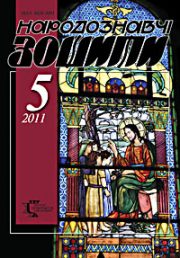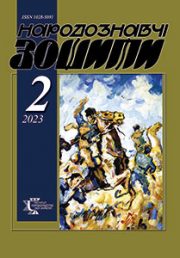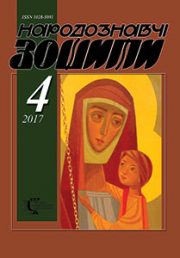The Ethnology Notebooks, 2018, № 5 (143), 1298—1307
UDK 766:7.012-027.3(477)
DOI https://doi.org/10.15407/nz2018.05.1298
Received 16.06.2018
ORCID ID https://orcid.org/0000-0002-8826-0135
Kosiv Vasyl Mykhailovych, Candidate of Art Studies, Associate Professor
of the Department of Graphic Design
of Lviv National Academy of Arts.
Kubiiovycha Street 38, 79011, Lviv, Ukraine.
Contacts: vasylkosiv@yahoo.com
Abstrakt. By comparing the examples of the Soviet Ukrainian posters and periodicals covers of the diaspora of 1945—1989, the article clarifies the peculiarities of using folk ornament as a means of national identification. Being at all levels of the composition and communication hierarchy, folk ornament in graphic design was one of the most flexible symbols. Authors` focus on a small number of embroidery and folk painting motives ensured recognition and expanded its semantic capabilities. As a result, the same ornaments were used in Soviet Ukraine and the Ukrainian diaspora, similar methods and means were popular, while the ideology of the message was opposite.
Keywords: folk ornament, graphic design, Ukrainian identity, Soviet Ukraine, Ukrainian diaspora, posters, periodicals covers.
REFERENCES
Transcript from December 3, 1959. All-Union Meeting on Political Poster. // Central State Archive-Museum of Literature and Art of Ukraine (CSAMLAU). F. 581. National Union of Artists. Op. 1. Spr. 764. Ark. 1–124 [In Russian].
Transcript from January 12, 1967. Discussion on the Exhibition of Political Posters. // CSAMLAU. F. 581. National Union of Artists. Op. 1. Spr. 1396. — Ark. 1–50. [In Ukrainian and Russian].
Second Republican Exhibition of Posters, April 18, 1974. // CSAMLAU. F. 986. Directorate of Exhibitions, National Union of Artists. Op. 1. Spr. 125. Ark. 1–25 [In Ukrainian and Russian].
Andrusiv, P. (1987). Art is the Strongest Weapon. In P. Andrusiv, Art is the Strongest Weapon. Articles, Speeches and Reviews (pp. 84—98). New York-Paris-Sydney-Toronto: Shevchenko Scientific Society [In Ukrainian].
Andrusiv, P. (1987). Ukrainian Artistic Culture. In P. Andrusiv, Art is the Strongest Weapon. Articles, Speeches and Reviews (pp. 3—32). New York-Paris-Sydney-Toronto: Shevchenko Scientific Society [In Ukrainian].
Bilous, L. (2008). Brocard Embroidery in Ukrainian Folk Clothes of the Second Half of the 19th — Beginning of the 20th Century. In Folk Costume as an Expression of National Identity (pp. 38—48). Kyiv: HIK. [In Ukrainian].
Hnizdovskyi, Ya. (1977). One More Time on the UVAN Panel on Art. Svoboda, 102. 2 [In Ukrainian].
History of Ukrainian Art. (1967). (Vol. 2). Kyiv: Naukova Dumka [In Ukrainian].
Kosacheva, O. (1876). Ukrainian Folk Ornament. Embroidery, Textiles, Easter Eggs. Kyiv: S.V. Kulzhenko [In Ukrainian].
Moshynska, O. (1980). Book of Ukrainian Embroidery. Cleveland: Khvyli Dnistra [In Ukrainian].
Petrykivka. Album of the Reproductions from the Collection of Dnipropetrovsk Art and History Museums [Introduction by Liudmila Tverska]. (2004). Dnipropetrovsk: Dniproknyha [In Ukrainian].
Petrova, O. (2004). On the Professional Artist’s Reception of the Folk Heritage. In O., Petrova, Art Studies Reflections (pp. 13—21). Kyiv: Academia [In Ukrainian].
Soloviy, Yu. (1978). The World Through the Smiling Eyes. Memoriam of Mykola Butovych. In Yu., Soloviy, On the Things Bigger than Stars (pp. 105—113). Munich: Suchasnist [In Ukrainian].
Soloviy, Yu. (1978). Creative and Pioneering Work of Hnizdovsky. (On the Occasion of Exhibition of His Woodcuts). In Yu., Soloviy, On the Things Bigger than Stars (pp. 62—69). Munich: Suchasnist [In Ukrainian].






